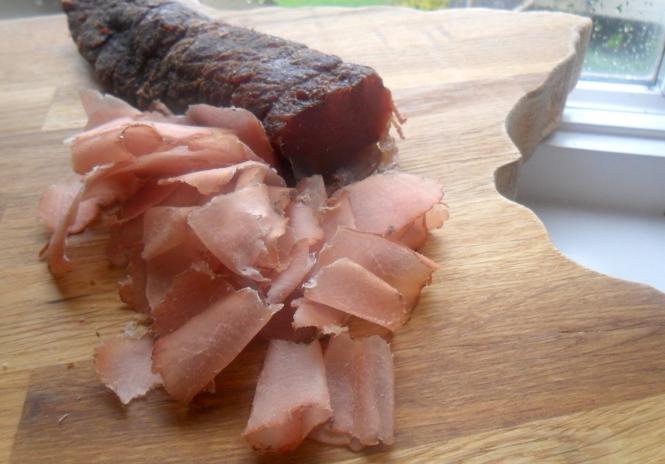As a hunter, one of my primary thoughts when I am out in the field or forest is: How am I going to use whatever I kill? One of the complaints I hear from people who hunt is that they get tired of the same old ways of preparing wild game. It seems like a lot of hunters let their wild game go to waste or give it away because they don’t understand how versatile wild game can be. I grew up in a family that took most of the venison we shot and turned it in to summer sausage or jerky -- not very creative. We ended up giving a lot of it away because after eating the first 30 pieces of jerky or summer sausage sandwiches every day for a week, you lose interest and don’t want to eat either anymore.
In the mid 90s I was gone in the Navy for a little over four years and didn’t hunt the entire time I was gone. When I came home and started hunting again; at the same time, I also started to really get into cooking. The first few cookbooks I bought had a lot of recipes for wild game, and as I experimented with some of these new recipes I discovered that just about every recipe can be adapted to use wild game. One of the first cookbooks I purchased was a book by Emeril Lagasse called Louisiana Real and Rustic, which included a whole chapter titled “Charcuterie”.
At the time I had no Idea what charcuterie was, but I was interested because some of the recipes involved wild game. The first recipe that caught my eye was for duck pastrami. I had just started duck hunting again and was doing very well, so I had plenty of ducks to experiment with. My first batch of duck pastrami was such a big hit that a lot of my friends would save all of their duck breasts for me to make this pastrami. I didn’t know it at the time, but charcuterie was going to become a very big part of my wild game cooking repertoire.
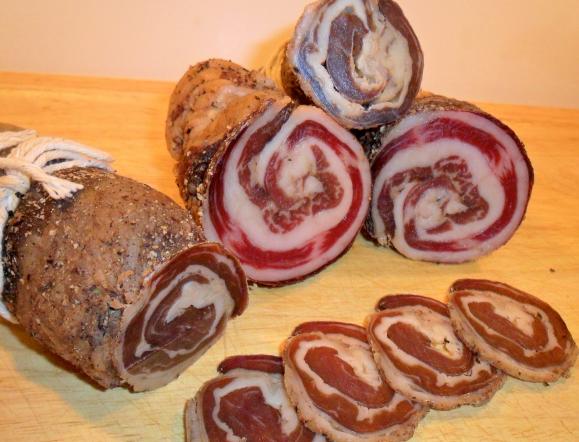 Wild boar pancetta
Wild boar pancetta
After the
pastrami turned out to be a hit, I was willing to try other kinds of
charcuterie. Because I was having so much success duck hunting, I tried making
duck confit for the first time and also made my first batch of duck sausage and
duck prosciutto. I expanded from there, using some wild boar I was given and
made wild boar pancetta and bacon. Before I knew it, I was dry-curing lonzino,
which is a spice-cured wild boar loin; I also made my first attempts at venison
prosciutto. Not all of my attempts were successful, but I had more successes
than failures.
Now, I make 60 to 70 pounds of sausage every year with all the different game from my hunts or from people who don’t know what to do with it. Today, I would say that I turn about 50% of the meat I hunt into some form of charcuterie, and I never get bored with what I eat.
Charcuterie
is a French term that basically means the process of preserving meat or the
preserved meat itself. Charcuterie includes, but is not limited to: curing
bacon, brining hams, and making sausages, galantines, terrines, pates, and
confit. All of these are methods of preserving meat, a process which was very
important before refrigeration was invented. Other than preservation, one of
the big benefits of making charcuterie is that it is very tasty. It can
transform meat that some people would never eat into delicacies that people
rave about. I know quite a few people who openly admitted hating duck and goose;
but after eating the duck and goose pastrami that I have made, they rave about
how good it is.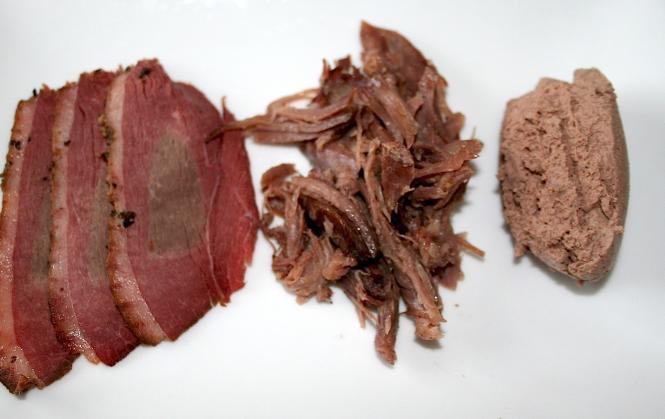 From left: goose pastrami, goose confit, goose liver pâté
From left: goose pastrami, goose confit, goose liver pâté
Charcuterie is a very large subject, and I would not possibly be able to adequately describe all aspects in a single blog post. So for this post I will focus on brining and confit. (If you are interested in learning all there is to know about charcuterie, I would suggest Michael Ruhlman and Brian Polcyn’s book, Charcuterie. It is an incredible book and does a much better job than I could of teaching all you need to know about charcuterie.)
Confit is a method of preserving meats by poaching the meat, and then storing it in its own fat. For example, you may have seen or heard of duck confit at some point; for duck or goose the primary cut of meat used is the leg and thigh portion. A standard confit takes a couple of days to make. The first step to confit is to salt your legs and let them sit overnight; rub a mixture of salt, thyme, bay leaf, garlic, and black pepper into the legs and then leave them to sit for up to a day. After they have sat overnight and up to 24 hours, you rinse all the remaining salt and herbs off the legs and submerge the meat in rendered duck fat. Then you poach it at very low temperature for 6-8 hours.
The process takes time, but I assure you it is well worth it. Traditionally, after the legs have been cooked in the fat, they would be packed into containers and covered with the rendered fat. At room temperature, the fat becomes solid and seals the meat off from the air. Before refrigeration, this was an excellent way to keep meat from going bad; stored this way in a cool dark area you could keep meat for a month or longer. In the freezer, confit will last almost forever. When you are ready to use the meat all you have to do is roast it in your oven for 10 minutes at 425 degrees and you end up with succulent, fall-off-the-bone tender duck or goose legs. They really can’t be beat. The confit can then be eaten by itself or added to almost any dish; I like mine with a little lingonberry jelly and some Jarlsberg cheese and a nice crusty bread.
Brining is another method of preserving meat that involves soaking meat in a salt solution and then cooking the meat. Ham, corned beef, and pastrami are all examples of brined meats. By soaking the meats in a salt solution, the salt water is absorbed into the meat; the salt water replaces the water in the cells of the meat and prevents the meat from breaking down or going bad. When brining meat, you use a special salt called sodium nitrite, which is a curing salt that further prevents spoilage of meat. Sodium nitrite is also the reason that brined meats have their characteristic pink color; it reacts with the meat and produces nitric oxide, which prevents iron breakdown in the fat of the meat and prevents it from going bad. For example, my duck pastrami is a form of a brined meat; I also brine antelope roasts to make corned antelope, and, in my opinion, it is better than any corned beef I have ever eaten.
When I started thinking about this post and what I was going to do for a recipe, I wanted to make something that would show off some of the different charcuterie techniques all in one meal. I wasn’t sure how to do that until I ate at Café Maude in Minneapolis. They serve a duck Bahn Mi, and it was fantastic. It uses duck confit and duck pastrami, as well as a duck liver pate, so I thought what better way to showcase several techniques than to make a similar sandwich. I didn’t have a duck in the freezer, but I did have a couple of geese that my buddy Ben Pena had given me. Here is my version of Café Maude’s duck Bahn Mi. It may seem like a lot of work, but, in my opinion, good food is never too much work.
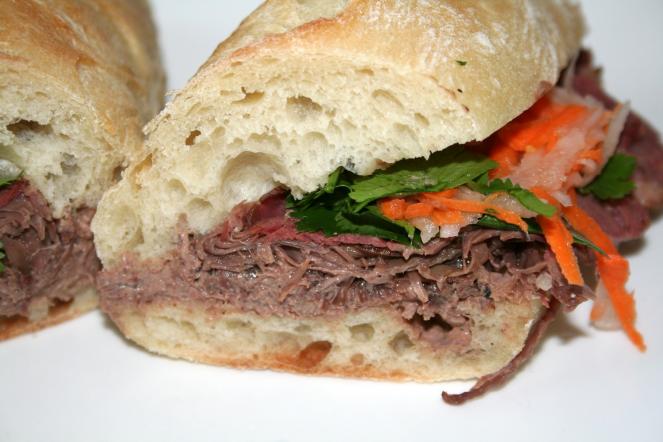 Goose Banh Mi
Goose Banh Mi -- My original recipe
Goose Banh Mi
Goose Banh Mi -- My original recipe
Makes about 6 sandwiches
Ingredients
- Goose pastrami (recipe below)
- Five-spice goose confit (recipe below)
- Goose pate (recipe below)
- Baguette (or several)
- Cilantro
- Carrots, julienned
- Daikon radish, julienned
- Rice Wine Vinegar
Instructions
1. Thirty minutes before you’re going to assemble the sandwich, start soaking the daikon and the carrots in the rice wine vinegar.
2. To assemble the sandwich, cut an 8 inch piece of baguette cut in half and spread about 2 tablespoons of pate on the bottom piece. Top with ¼ cup of goose confit, and then the slices of goose pastrami. Add some of the daikon and carrots and finish with some cilantro leaves.
Goose Pastrami
Adapted from Emeril Lagasse’s Louisiana Real and Rustic
Ingredients
- 2 goose breasts with the skin on (about 1 pound each)
- 1 tablespoon black peppercorns, plus 2 tsp ground black pepper to roll the brined breasts in
- 2 tsp dry thyme
- 3 bay leaves
- 1 tsp whole cloves
- 3 cloves of garlic (smashed)
- 2 tsp whole juniper berries plus 1 tablespoon ground juniper berries to mix with ground black pepper
- 4 cups water
- ½ cup brown sugar
- ½ cup kosher salt
- 1/10 ounce of insta cure # 1 (pink curing salt)
Instructions
1. Bring the water, brown sugar, and both salts to a boil and heat until they dissolve completely. Then add the rest of the ingredients to the brine, turn off the heat, and let stand until room temperature.
2. Place the goose breasts in the room-temperature brine and refrigerate for 48-72 hours, turning the breast over in the brine every day.
3. After the breasts have been brined, dry them off and cover the skin side of the breast with the black pepper and juniper mix.
4. Place in a smoker and smoke at 180 degrees for 5-6 hours or until the breasts reach an internal temperature of 165 degrees.
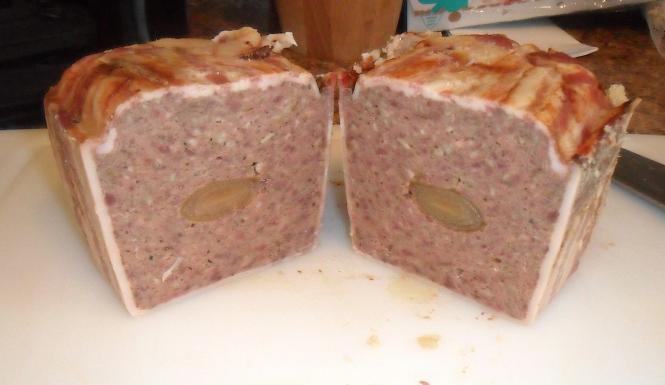 An example of pâté -- this one made of venison
An example of pâté -- this one made of venison
Goose Liver Pâté
My own original recipe
Ingredients
- 12 ounces goose livers
- 1/10 ounce insta cure #1
- 2 cups port or fruity wine, I used an apple and black current wine
- 3 bay leaves
- 3 cloves
- 1 tsp black peppercorns
- ½ of a small white onion
- 8 ounces whipped cream cheese
- 1 minced garlic clove
- 2 tablespoons brandy
- ¼ tsp dry thyme
- ¼ tsp white pepper
- A dash of nutmeg
Instructions
1. Mix the wine, salt, and spices together and add the livers. Marinate the livers for 24 hours in the refrigerator, then remove the livers from the marinade and dry completely.
2. Pan fry the livers in two tablespoons bacon fat for a couple of minutes on each side.
3. Add the livers and bacon fat to a food processor, then add onion, cream cheese, garlic, brandy, thyme, white pepper, and nutmeg. Blend until smooth and creamy. Taste and add salt, if necessary (it should be a little salty because as it cools the salt will mellow).
4. Transfer the mixture to a fine mesh sieve and press it through the mesh to get a very smooth and creamy pate. Chill before serving.
Five Spice Goose Confit
My original recipe
Ingredients
- 4 goose leg and thigh portions
- ¼ cup kosher salt
- 1 tablespoon Chinese five spice powder
- 1 tsp garlic powder
- ½ tsp red pepper flakes
- 3 bay leaves
- Enough duck fat to cover the legs
Instructions
1. Mix together the salt and spices and rub the goose legs with this mixture. Refrigerate for 24 hours.
2. After 24 hours, rinse all the salt mixture off the legs and dry completely.
3. Place the legs in a heavy ovenproof pot and cover with duck or goose fat.
4. Place in the oven at 200 degrees for 5-6 hours. You will know that the legs are done when the meat and skin have pulled away from the knuckle on the leg bone.
5. If you are going to store your confit, you can place the legs in a Ziploc freezer bag with some of the rendered fat and put in the freezer. Or you can pack the legs into a container and cover with remaining rendered fat.
6. When you are ready to use the legs, preheat the oven to 425 and then roast the legs for 10 to 15 minutes until the skin get crispy.

Jamie Carlson lives in Burnsville, MN with his wife, Amanda, and their two kids Eleanor and Charlie. He works as an Rn at the Minneapolis VA hospital. He enjoys hunting, fishing, foraging, and, of course, cooking. He believes that all food can be tasty if it is prepared with care, and he writes about his adventures cooking everything from Pickled Venison Heart to Roasted Dove on his food blog, You Have to Cook it Right. Follow him at @youcookitright. His last post for SGT was What to Do With All That Offal.

